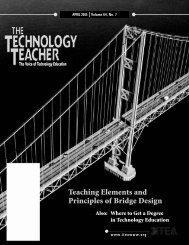K-12 Engineering Education Standards: - International Technology ...
K-12 Engineering Education Standards: - International Technology ...
K-12 Engineering Education Standards: - International Technology ...
Create successful ePaper yourself
Turn your PDF publications into a flip-book with our unique Google optimized e-Paper software.
students should determine the curriculum. Rather, this is to<br />
suggest that design activities should include opportunities<br />
for students to explore and experiment in a creative<br />
environment. Sheldon and Biddle (1998) observe the impact<br />
of student engagement on learning:<br />
…if students are challenged, if their interests in the<br />
subject matter are encouraged, if they are given autonomy<br />
support, then their intrinsic interests, their motivation<br />
for learning, and their test scores will all grow more<br />
effectively. (p. 176)<br />
Although maximum achievement may be the technology<br />
teacher’s goal, if student attention is focused on completing<br />
prescriptive assignments, growth will likely not be<br />
maximized. In contrast, if the students are provided with<br />
some measure of choice and design challenges that support<br />
their individual interests, their performance and retention<br />
will grow accordingly.<br />
An Application<br />
Close your eyes for a moment and enter the world of<br />
the middle school or high school technology education<br />
student. This is a world of few personal spaces and still<br />
fewer individual choices. In fact, as you travel down the<br />
hallway, you will note that your student locker is one of<br />
the few private spaces that you have in the public school.<br />
Now open your eyes and consider the student lockers that<br />
you have seen during your own school visits. Students’<br />
deep ownership is apparent when walking down a school<br />
hallway, as students tend to personalize, decorate, and<br />
enshrine their locker spaces. For these reasons we have<br />
selected the activity of package design, more specifically<br />
the package design of a locker organizer, to invigorate the<br />
traditional drafting classroom and infuse more design and<br />
creativity into student CAD drawings.<br />
Locker Design Challenge<br />
Overview<br />
Students will plan, draw, and produce a cardboard<br />
prototype of a school locker organizer that can be produced<br />
in one dimension and then creased, folded, and assembled<br />
into a working prototype.<br />
Challenge<br />
Create and produce a full-scale school locker organizer<br />
that will store textbooks, notebooks, writing utensils,<br />
mobile phones, and various other items commonly found<br />
in public schools.<br />
Time Limits<br />
The time to complete this assignment will vary between<br />
classrooms based on class period length, but generally this<br />
would work as a one-month-long school project.<br />
Parameters<br />
A. The Locker Design Challenge is an individual<br />
assignment. However, collaborative problem solving is<br />
encouraged. No two locker organizers should be alike.<br />
B. The locker organizer must be designed in such a way<br />
as to allow for the final product to be designed using<br />
CAD software, printed or plotted using a printer,<br />
affixed to card stock, and then cut, creased, folded, and<br />
formed into a finished prototype.<br />
C. The locker organizer must be comprised of no more<br />
than three (3) components (each affixed to card stock),<br />
with the overall dimensions of the organizer being:<br />
1. 30” height<br />
2. 11¾”width<br />
3. 10¾” depth<br />
D. The drawings for each component must contain an<br />
accurately dimensioned orthographic projection, and<br />
an isometric view of the parts.<br />
E. No fasteners, glue, or other types of adhesives may<br />
be used in the design. Each component must be<br />
self-standing or interlock together with the other<br />
components.<br />
F. Prototypes must be constructed of 1/8” or smaller<br />
corrugated cardboard, card stock, railroad board, or a<br />
like material.<br />
Evaluation<br />
Designs are evaluated for design creativity and the<br />
effectiveness of the prototype. Additionally, the design will<br />
7 • <strong>Technology</strong> and <strong>Engineering</strong> Teacher • February 2011
















